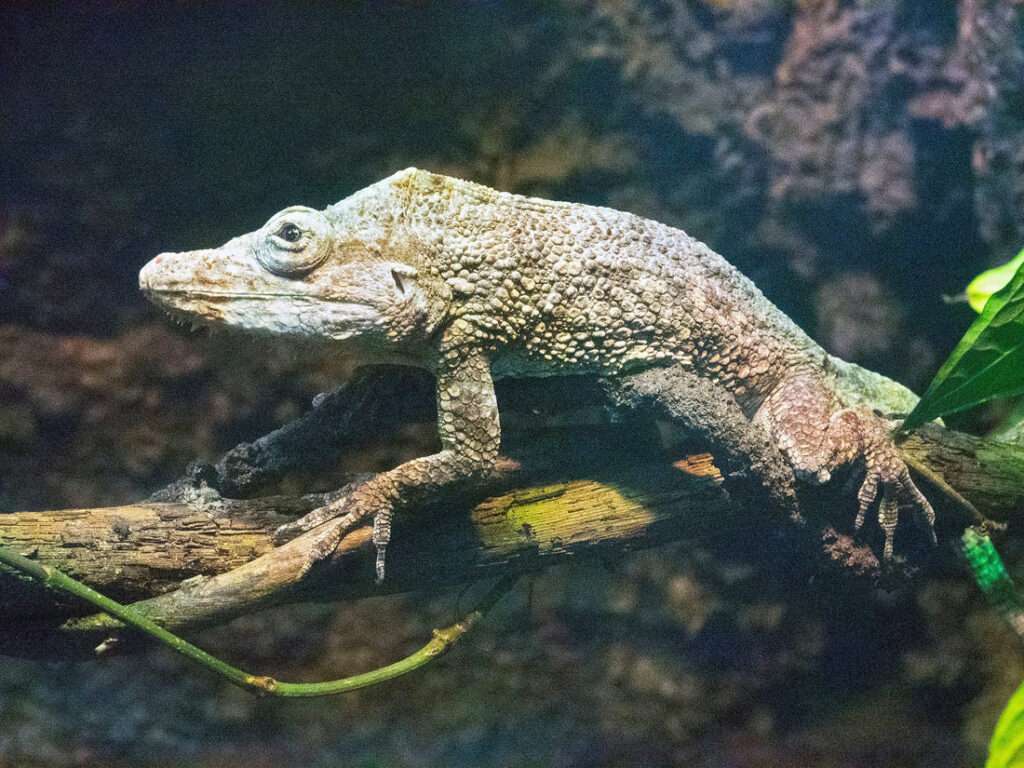
Description:
Scientific name: Anolis barbatus
Life span: 3-6 years
Adults typically have tails that are somewhat shorter than their bodies, an average snout-vent length of up to 18 cm (7 in), and negligible sexual dimorphism. All of these are native to Cuba, are relatively large for anoles, have powerful heads, are dull gray or dull brown in color, and have blunt teeth that are used to crush snails and other invertebrates, which make up the majority of their diet. These species lack the capacity to autotomize their tails, which is unusual for anoles.
Native Region/Habitat
Cuban woodlands are now the only place where the Cuban false chameleon may be found. Together with some urban areas, these lizards can also be found in coffee and fruit plantations.
Behavior:
In both captivity and their natural environment, Cuban false chameleons are often timid, quiet, and inactive. Rarely do these lizards bite. These reptiles should not be handled frequently because they are easily stressed. This species will open its mouth and push out its tongue as a warning indication when it is anxious or frightened. A bite may then follow. If the lizard exhibits this behavior, keep it alone.
Particularly when females are present, male Cuban false chameleons have a propensity for territorial behavior. Male lizards should be kept in separate enclosures since they may get aggressive and fight.

Care As a pet/In captivity:
Enclosure size:
A glass vivarium for a Cuban false chameleon should be 2 feet by 1.5 feet by 2 feet in size. Provide a habitat that is tall enough to accommodate branches or ornaments the Cuban false chameleon can climb and sit on because they are accustomed to living in trees.
To assist regulate humidity inside, think about placing a screen lid over the vivarium that is partially covered with foil.
Temperature and Humidity:
The vivarium should be kept at a temperature of around 70°F, while the basking area should be kept at a temperature of about 90°F. The vivarium should have a digital thermostat to track temperatures and make sure they stay steady.
Because lizards are susceptible to dehydration, it’s important to maintain a steady humidity level inside the habitat. Set the humidity to about 70%. To maintain the proper amount of humidity during dry seasons, it might be required to mist the cage with water. Including living plants in the enclosure substantially aids humidity maintenance.
Food and Water:
Make sure the lizards always have access to water because Cuban false chameleons must stay constantly hydrated.
Despite being able to drink from a bowl, Cuban false chameleons choose drinking water that drips onto a flat object like a leaf or a rock. Install a drip system and direct it towards a flat surface to satisfy this preference.
Insects and snails are typically found in these lizards’ diets. Approximately twice a week, purchase snails from reliable breeders and use tongs to give the snails to the lizards. The food source for Cuban false chameleons is insects. Use tongs with caution when feeding crickets since if they are allowed to roam freely inside the vivarium, they could bite the lizard.
Table





